Strategic Project Management Unit Title: Strategic Project Management
Added on 2020-10-22
40 Pages5168 Words324 Views
Unit Title: Strategic project management
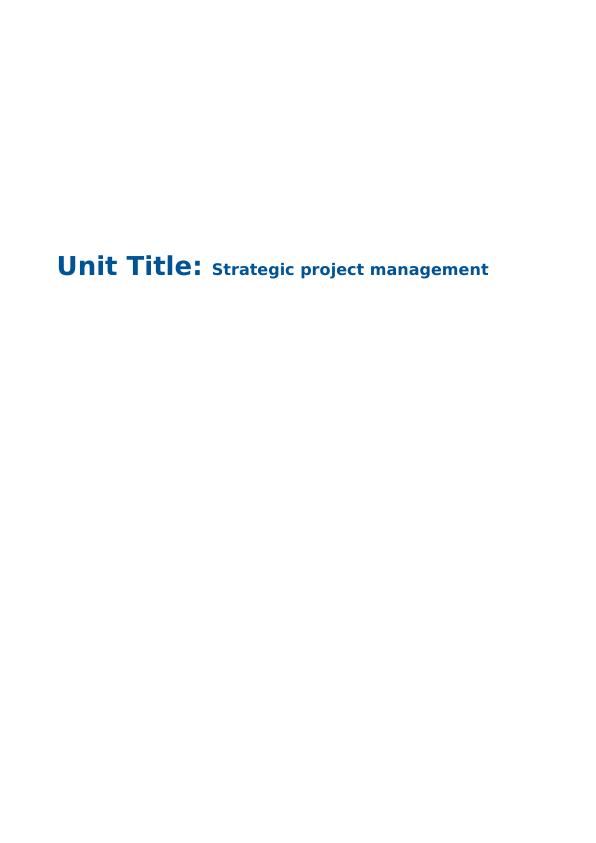
Contents
Introduction ................................................................................................................... 3
Task 1 ............................................................................................................................ 3
Task 2: ......................................................................................................................... 19
Task 3: ......................................................................................................................... 19
Appendix 1 References ................................................................................................ 20
Introduction ................................................................................................................... 3
Task 1 ............................................................................................................................ 3
Task 2: ......................................................................................................................... 19
Task 3: ......................................................................................................................... 19
Appendix 1 References ................................................................................................ 20

Introduction
Project can be defined as systematic, goal-oriented, and one-time
endeavour to create a product or service within a specified time, cost and
quality constraints.
As responsible for leading and delivering a project for the organisation. The
role involves ensuring support from all stakeholders and to successfully
deliver a project that meets organisational strategic objectives, projects
impact on the organisation strategic objectives, phases and specification
of the project plan, role of sponsor and stakeholders, implementation
agreement process, stakeholders support and the evaluation process of
measuring project performance.
Defining these topics, the project objectives are structurally broken down
into a series of manageable tasks, these are used to evaluate and
measured project performance.
Task 1:
A.C. 1.1 - Assess the purpose of project planning and
management
Project planning and management are the two activities where the
necessary actions are defined, prepared, integrated and coordinate the
various planning phases a project undergoes (Harris, 2017).
According to Leigh Richards (small business), the planning of a project is the
heart of the project life cycle, and tells the direction of travel the project and
the get there. The planning involves activities such as:
- Breaking a complex process down into several simpler components
- Providing visibility for obscure or ambiguous tasks of the project
- Providing a single point of reference for everyone
- Enforcing scrutiny of the sequence and nature of events
- Providing a baseline against which execution of the project can be compared
- Anticipating likely events and providing a mitigation strategy
The project might be threatened to exceed the limit of the organisation
control, to maintain control, the organisation need to make a use of tools
such as: project controls plan.
Project control is a process for controlling the investment of resources, it
is considered the communication tool for instituting the control process ().
Characteristics of the project:
There are certain characteristics of an project that should be examined
from the above definition that at beginning and at the end there are time
aspect and helps to reach at desirable outcomes in positive manner. It also
elaborates the process aspects to reach at its end results. It describe about
requirement of resources in an controlled manner and it helps in manage
activities in form of tasks and team management that plays very crucial
role.
Project can be defined as systematic, goal-oriented, and one-time
endeavour to create a product or service within a specified time, cost and
quality constraints.
As responsible for leading and delivering a project for the organisation. The
role involves ensuring support from all stakeholders and to successfully
deliver a project that meets organisational strategic objectives, projects
impact on the organisation strategic objectives, phases and specification
of the project plan, role of sponsor and stakeholders, implementation
agreement process, stakeholders support and the evaluation process of
measuring project performance.
Defining these topics, the project objectives are structurally broken down
into a series of manageable tasks, these are used to evaluate and
measured project performance.
Task 1:
A.C. 1.1 - Assess the purpose of project planning and
management
Project planning and management are the two activities where the
necessary actions are defined, prepared, integrated and coordinate the
various planning phases a project undergoes (Harris, 2017).
According to Leigh Richards (small business), the planning of a project is the
heart of the project life cycle, and tells the direction of travel the project and
the get there. The planning involves activities such as:
- Breaking a complex process down into several simpler components
- Providing visibility for obscure or ambiguous tasks of the project
- Providing a single point of reference for everyone
- Enforcing scrutiny of the sequence and nature of events
- Providing a baseline against which execution of the project can be compared
- Anticipating likely events and providing a mitigation strategy
The project might be threatened to exceed the limit of the organisation
control, to maintain control, the organisation need to make a use of tools
such as: project controls plan.
Project control is a process for controlling the investment of resources, it
is considered the communication tool for instituting the control process ().
Characteristics of the project:
There are certain characteristics of an project that should be examined
from the above definition that at beginning and at the end there are time
aspect and helps to reach at desirable outcomes in positive manner. It also
elaborates the process aspects to reach at its end results. It describe about
requirement of resources in an controlled manner and it helps in manage
activities in form of tasks and team management that plays very crucial
role.
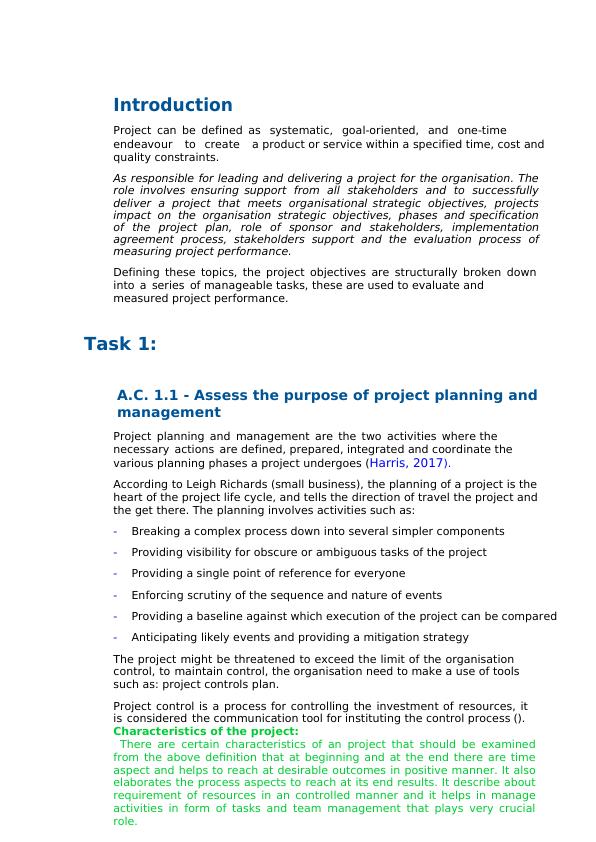
Purpose of project to carried out:
There are many reasons to conduct project and behind it there are many ill
reasons behind that to build an effective system organisation have to
implement various kinds of project with to earn money various projects take
place. To lead in market organisation have to bring changes in their works
and procedures so that competitive advantages should be gain. In current
system should be updated in proper way and to bring revolutionized results
in an industry also the major reasons behind carry out a project. The main
purpose of project planning is to describes the parameters and objectives of
individuals business projects. It clarifies why the plan is being implemented
and the ultimate purpose the plan will serve and offer.
This project is carried out to understand the impact of projects and project management on
strategic objectives, interpret the elements of a project process & plan and analyse how to
implement the project plan and evaluate the outcomes.
which should have a Plan Do Check Act (PDCA) which should include:
Planning: It is a process of thinking about various activities which is
required by everyone in order to achieve their predetermine goals. It is
the first and foremost function performed by management team of the
company. This function involves decisions related with what to do, how to
do, when to do and many more. Planning process involves various stages:
Recognize need for action: It is one of the important and essential
process where manager of the company examine the external as well as
internal opportunity. After realizing the opportunities, management team
need to recognise what action should be taken in order to grab
opportunities. For example, managers recognise that if they implement
new technology they can provide high quality products to their
customers.
Setting objectives: In this second stage, management team of the
company set goals and objectives according to which more planning has
to be made by other department. As per the above example to
management team of the company set goals and objectives. It is the duty
of managers to communicate organisational goals and objectives to their
staff members.
Identifying Alternatives: After setting goals, managers shout identify
different alternatives which will be helpful in order to achieve
organisational objectives. There are various alternatives available for
managers, which must be identified by them. For example, management
team of the company decides the need for implementing new technology
within the organisation, but on the other hand managers should identify
various other alternatives which will fulfil the ultimate goal of the
company.
Examine best alternative: After analysing different alternatives, it is
the duty of managers to adopt best and suitable alternatives available to
them. According to the above case where managers need to implement
new technology in the organisation. If managers of the company, find this
best suitable for the organisation, they can adopt it.
Implementation: After doing proper planning and evaluation, it is the
management team call, when to implement the selective and best suitable
alternative. It is the process where all planned actions must be
implemented in order to achieve their goals and objectives.
Performance Measurement: It is the stage where management team along
with staff members should measure the performance of their employees.
On the other hand managers should also examine their operational
activities on a regular basis. For this supervisors or departmental head
should maintain daily basis records, with the help of which management
There are many reasons to conduct project and behind it there are many ill
reasons behind that to build an effective system organisation have to
implement various kinds of project with to earn money various projects take
place. To lead in market organisation have to bring changes in their works
and procedures so that competitive advantages should be gain. In current
system should be updated in proper way and to bring revolutionized results
in an industry also the major reasons behind carry out a project. The main
purpose of project planning is to describes the parameters and objectives of
individuals business projects. It clarifies why the plan is being implemented
and the ultimate purpose the plan will serve and offer.
This project is carried out to understand the impact of projects and project management on
strategic objectives, interpret the elements of a project process & plan and analyse how to
implement the project plan and evaluate the outcomes.
which should have a Plan Do Check Act (PDCA) which should include:
Planning: It is a process of thinking about various activities which is
required by everyone in order to achieve their predetermine goals. It is
the first and foremost function performed by management team of the
company. This function involves decisions related with what to do, how to
do, when to do and many more. Planning process involves various stages:
Recognize need for action: It is one of the important and essential
process where manager of the company examine the external as well as
internal opportunity. After realizing the opportunities, management team
need to recognise what action should be taken in order to grab
opportunities. For example, managers recognise that if they implement
new technology they can provide high quality products to their
customers.
Setting objectives: In this second stage, management team of the
company set goals and objectives according to which more planning has
to be made by other department. As per the above example to
management team of the company set goals and objectives. It is the duty
of managers to communicate organisational goals and objectives to their
staff members.
Identifying Alternatives: After setting goals, managers shout identify
different alternatives which will be helpful in order to achieve
organisational objectives. There are various alternatives available for
managers, which must be identified by them. For example, management
team of the company decides the need for implementing new technology
within the organisation, but on the other hand managers should identify
various other alternatives which will fulfil the ultimate goal of the
company.
Examine best alternative: After analysing different alternatives, it is
the duty of managers to adopt best and suitable alternatives available to
them. According to the above case where managers need to implement
new technology in the organisation. If managers of the company, find this
best suitable for the organisation, they can adopt it.
Implementation: After doing proper planning and evaluation, it is the
management team call, when to implement the selective and best suitable
alternative. It is the process where all planned actions must be
implemented in order to achieve their goals and objectives.
Performance Measurement: It is the stage where management team along
with staff members should measure the performance of their employees.
On the other hand managers should also examine their operational
activities on a regular basis. For this supervisors or departmental head
should maintain daily basis records, with the help of which management

team as well as project manager can easily measure performance of
employees. In addition to this, if employees need any kind of training for
manufacturing products and services, managers can provide them after
examining all factors.
Performance Assessment: It is the method, where employee should
perform tasks and evaluate it after performing. It will aid the employees
in analysing their performance as well as they will be able to know where
they stand in the organisation. For example, management team of the
company implement new technology in their organisation. It is the duty of
project manager to examine performance of their employees.
employees. In addition to this, if employees need any kind of training for
manufacturing products and services, managers can provide them after
examining all factors.
Performance Assessment: It is the method, where employee should
perform tasks and evaluate it after performing. It will aid the employees
in analysing their performance as well as they will be able to know where
they stand in the organisation. For example, management team of the
company implement new technology in their organisation. It is the duty of
project manager to examine performance of their employees.

Figure 1 – Project Controls Process
The control process may focus mainly on the quantitative resource control
subset of the project management process, and here, the project controls
plan should be considered a compliment to the project execution plan. Prior
to developing the controls plan a requirements elicitation and analysis
process should be completed. The elicitation and analysis process will
help in identifying the stakeholders (decision-makers and sponsors) needs,
and expectations and planning, communication, implementation,
measurement, and assessment (Too and Weaver, 2014). Figure 1
represents the project controls process and cost management framework.
The tools to be used for the exercise of project management are such as:
Gantt chart, Logic Network, Program Evaluation and Review Technique
(known as PERT chart), Product Breakdown Structure and Work Breakdown
Structure are standard tools used in project planning. Pavel Aramyan (easy
project articles) Below is a short description for each:
- Gantt Chart: Developed by Henry Laurence Gantt in 1910, its first
introduction in 1917 Gantt chart have become a popular standard within
the industry. It shows the phases, tasks, milestones and resources
needed as part of a project and tracks tasks across time also track both
time and interdependencies between tasks on its everyday use
(Martinsuo and Killen, 2014).
- Logic Network: It indicates the sequence of activities in a project over
time. shows which activity logically precedes or follows another activity.
The logic network can be used to identify the milestones and critical
phases of a project. It helps organisation to understand the
dependencies in project, timescale, workflow and it reveals valuable
information that may otherwise be overlooked.
- Program Evaluation and Review Technique Chart: it is a method
for the tasks analysis involved in project completion, specifically the
time needed to complete each task and identifying the minimum time
required for project completion. Developed in 1958 as part of the
Polaris mobile submarine-launched ballistic missile project by the
United States Department of Defence’s US Navy Special Projects Office.
The control process may focus mainly on the quantitative resource control
subset of the project management process, and here, the project controls
plan should be considered a compliment to the project execution plan. Prior
to developing the controls plan a requirements elicitation and analysis
process should be completed. The elicitation and analysis process will
help in identifying the stakeholders (decision-makers and sponsors) needs,
and expectations and planning, communication, implementation,
measurement, and assessment (Too and Weaver, 2014). Figure 1
represents the project controls process and cost management framework.
The tools to be used for the exercise of project management are such as:
Gantt chart, Logic Network, Program Evaluation and Review Technique
(known as PERT chart), Product Breakdown Structure and Work Breakdown
Structure are standard tools used in project planning. Pavel Aramyan (easy
project articles) Below is a short description for each:
- Gantt Chart: Developed by Henry Laurence Gantt in 1910, its first
introduction in 1917 Gantt chart have become a popular standard within
the industry. It shows the phases, tasks, milestones and resources
needed as part of a project and tracks tasks across time also track both
time and interdependencies between tasks on its everyday use
(Martinsuo and Killen, 2014).
- Logic Network: It indicates the sequence of activities in a project over
time. shows which activity logically precedes or follows another activity.
The logic network can be used to identify the milestones and critical
phases of a project. It helps organisation to understand the
dependencies in project, timescale, workflow and it reveals valuable
information that may otherwise be overlooked.
- Program Evaluation and Review Technique Chart: it is a method
for the tasks analysis involved in project completion, specifically the
time needed to complete each task and identifying the minimum time
required for project completion. Developed in 1958 as part of the
Polaris mobile submarine-launched ballistic missile project by the
United States Department of Defence’s US Navy Special Projects Office.
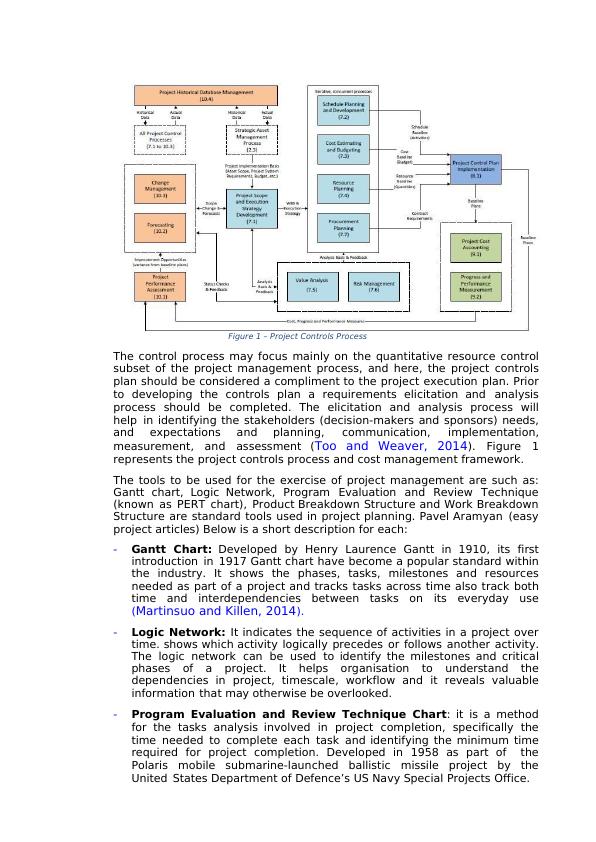
- Product Breakdown Structure (PBS): Product Breakdown Structure
(PBS) is an exhaustive, hierarchical tree structure of components that
make up a project deliverable, arranged in whole-part relationship. It
clarifies what is to be delivered by the project and can contribute to
building a work breakdown structure.
- Work Breakdown Structure (WBS): It is a hierarchical decomposition
of the deliverables needed for project completion for much project
planning. It breaks the deliverables down into manageable work
packages that can be scheduled, costed and have responsibilities
assigned to them. Created by the United States Department of Defence
the Work as part of the Polaris mobile submarine-launched ballistic
missile project.
The purpose of the control process is to provide a comprehensive baseline
of the objectives to be achieved by the project, how they are to be achieved,
who will be involved, how they will be reported and measured and how
information will be communicated (Papke-Shields and Boyer-Wright,
2017). The project controls plan should be used as a reference for decisions
made on the project and for clarification.
Project management is described as a process by which the project is
defined, planned, monitored, controlled and delivered such that the set
objectives are achieved, and this process offers strategical qualities and
direction to the defined milestones (Moore, 2010). During the exercise of
the project management, risks are to be identified strategically including
the risk management strategy at the start of the project so that they are
accounted for before reaching the implementation phase. The early
identification of risks increases: product quality, successful traits. (D. Lock
2007)
The project management exercise is documented and detailed and should
be used as a reference throughout the project to ensure that the
management of the project is carried out as outlined consistently and in
line with the described process. Although the project management plan
should be developed at the project initiation stage and should evolve as the
project progresses and be updated with the latest relevant information as
required.
Vadim Katcherovski describes how the project management plan provides
essential project information and can used to introduce project members
to the project requirements and planned phases and objectives. Project
management plan (2020), The project management plan should as
minimum detailed sections: Executive summary, Strategic Organisation
strategic alignment, Project scope, Quality specifications, Project
assumptions Feasibility assessment and contingency plans, Constraints,
Human resource requirements, Material/equipment requirements, Project
schedule and milestones, Budget/cost estimate, Risk Management, Project
issues, Change management, Communication management, Related
product and deliverables, Approval and release process.
- Executive summary: This section includes descriptions, at a high level,
of key elements of the project that are detailed throughout the project
plan.
- Strategic/organisational alignment: must be determined which
organisational objectives will be supported by undertaking the project.
This section should also include the results of the project’s stakeholder
analysis.
- Project scope: The purpose and objectives of the project are to be
stated in this section. A definition of the scope of the project as well as
(PBS) is an exhaustive, hierarchical tree structure of components that
make up a project deliverable, arranged in whole-part relationship. It
clarifies what is to be delivered by the project and can contribute to
building a work breakdown structure.
- Work Breakdown Structure (WBS): It is a hierarchical decomposition
of the deliverables needed for project completion for much project
planning. It breaks the deliverables down into manageable work
packages that can be scheduled, costed and have responsibilities
assigned to them. Created by the United States Department of Defence
the Work as part of the Polaris mobile submarine-launched ballistic
missile project.
The purpose of the control process is to provide a comprehensive baseline
of the objectives to be achieved by the project, how they are to be achieved,
who will be involved, how they will be reported and measured and how
information will be communicated (Papke-Shields and Boyer-Wright,
2017). The project controls plan should be used as a reference for decisions
made on the project and for clarification.
Project management is described as a process by which the project is
defined, planned, monitored, controlled and delivered such that the set
objectives are achieved, and this process offers strategical qualities and
direction to the defined milestones (Moore, 2010). During the exercise of
the project management, risks are to be identified strategically including
the risk management strategy at the start of the project so that they are
accounted for before reaching the implementation phase. The early
identification of risks increases: product quality, successful traits. (D. Lock
2007)
The project management exercise is documented and detailed and should
be used as a reference throughout the project to ensure that the
management of the project is carried out as outlined consistently and in
line with the described process. Although the project management plan
should be developed at the project initiation stage and should evolve as the
project progresses and be updated with the latest relevant information as
required.
Vadim Katcherovski describes how the project management plan provides
essential project information and can used to introduce project members
to the project requirements and planned phases and objectives. Project
management plan (2020), The project management plan should as
minimum detailed sections: Executive summary, Strategic Organisation
strategic alignment, Project scope, Quality specifications, Project
assumptions Feasibility assessment and contingency plans, Constraints,
Human resource requirements, Material/equipment requirements, Project
schedule and milestones, Budget/cost estimate, Risk Management, Project
issues, Change management, Communication management, Related
product and deliverables, Approval and release process.
- Executive summary: This section includes descriptions, at a high level,
of key elements of the project that are detailed throughout the project
plan.
- Strategic/organisational alignment: must be determined which
organisational objectives will be supported by undertaking the project.
This section should also include the results of the project’s stakeholder
analysis.
- Project scope: The purpose and objectives of the project are to be
stated in this section. A definition of the scope of the project as well as
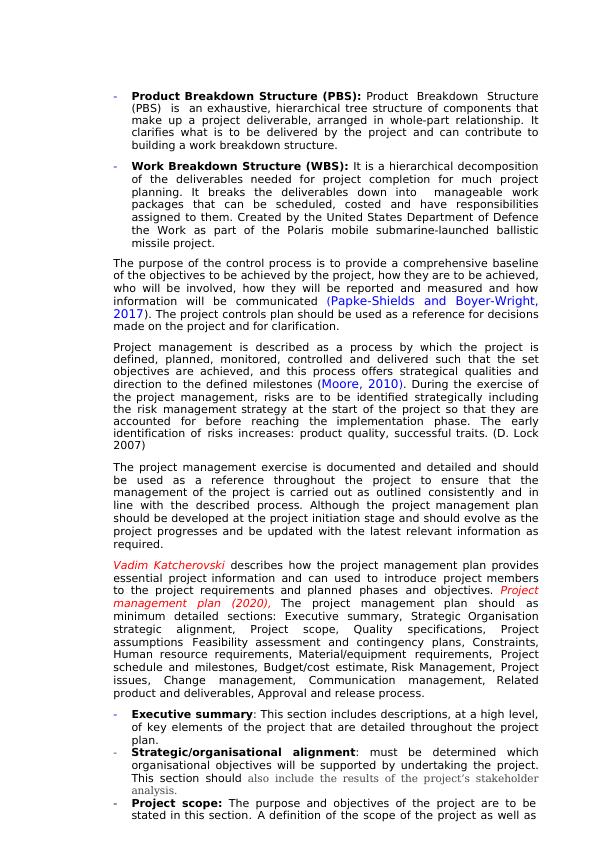
the deliverables. The product breakdown
structure and the work breakdown structure are to be determined within
this section.
- Quality specifications: Describing the product or service
performance criteria from customer perspective.
- Project assumptions: Clarifying grey areas in the
project scope.
structure and the work breakdown structure are to be determined within
this section.
- Quality specifications: Describing the product or service
performance criteria from customer perspective.
- Project assumptions: Clarifying grey areas in the
project scope.
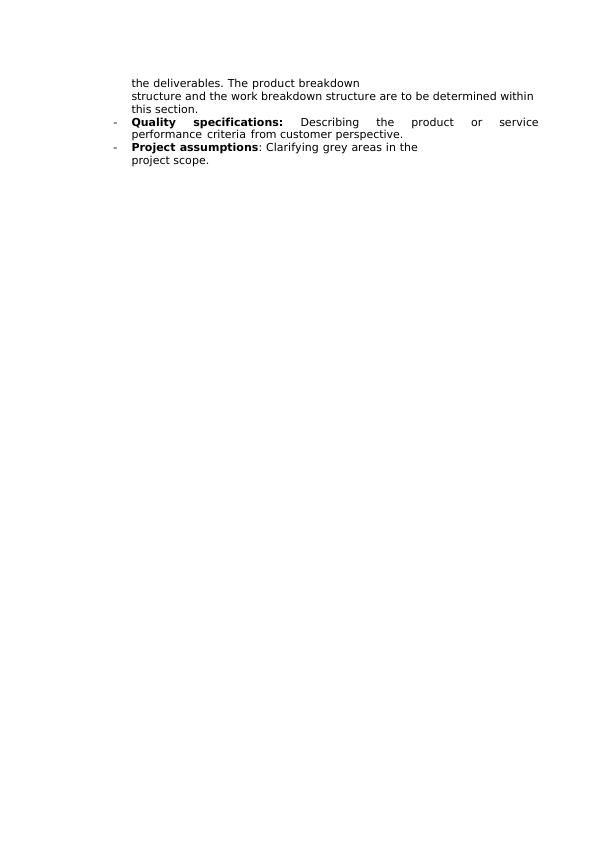
End of preview
Want to access all the pages? Upload your documents or become a member.
Related Documents
Project Management in Businesslg...
|16
|3774
|496
Managing Projectslg...
|15
|3641
|33
PROJECT MANAGEMENTlg...
|11
|1767
|63
Project Management Methodologylg...
|6
|1073
|188
(PDF) Project Management Assignmentlg...
|13
|4126
|317
Project Management Assignment (PDF)lg...
|19
|4730
|167
